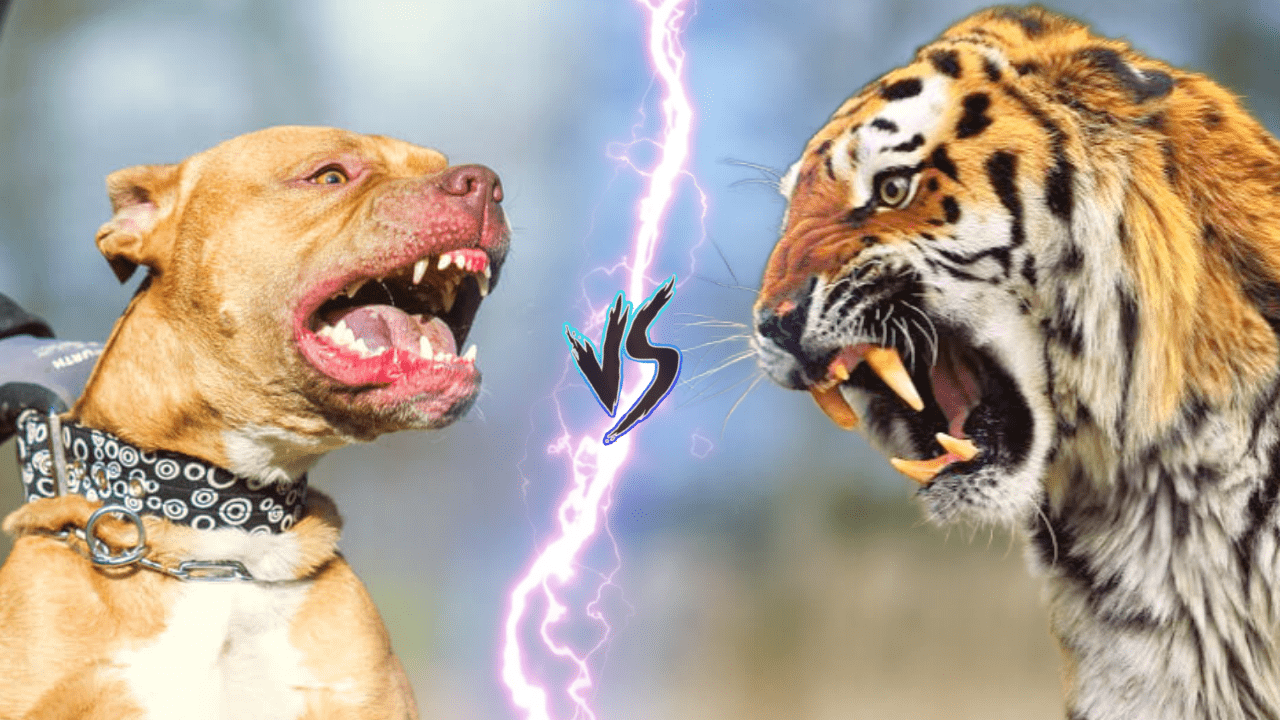Table of Contents

Introduction
Siberian Tiger vs Sabertooth: Who Will Win? Two majestic feline predators have captured humanity’s imagination deep within the annals of history: the Siberian Tiger and the Sabertooth. One roams the icy wilderness of Siberia, while the other is a distant memory from another era. In this first-of-its-kind comparison, we’ll look at the characteristics of these magnificent creatures and speculate on what might happen if they crossed paths in the ultimate battle for survival.
Siberian Tiger – The Ruler of the Taiga
The Siberian Tiger, also known as the Amur Tiger, is the largest species of living cat. Awe and reverence are inspired by its majestic presence and breathtaking beauty. This fearsome predator has adapted to survive in harsh environments, primarily the cold coniferous forests and icy riverbanks of Siberia. The Siberian Tiger, with its robust build and powerful limbs, is a stealthy hunter with lightning-fast reflexes, capable of ambushing its prey with deadly precision. Its striking orange and black striped fur provides excellent camouflage among the dense foliage of the taiga, allowing it to stalk and surprise its prey with ease.
Sabertooth – The Enigmatic Fossil
During the Pleistocene epoch, the Sabertooth, scientifically known as Smilodon, dominated the prehistoric landscapes. The Sabertooth, unlike the Siberian Tiger, is not a true tiger but rather a distant relative with amazing adaptations. One of the most distinguishing features of this ancient predator are its elongated canine teeth, which can grow to be 11 inches long. These sabertooth canines were created to deliver lethal bites to their prey, capable of severing vital arteries and incapacitating even the largest herbivores. The Sabertooth thrived in a variety of habitats, including grasslands and forests, and was an expert at ambush tactics, using its powerful forelimbs and robust build to immobilize its prey.
The Hypothetical Showdown (Siberian Tiger vs Sabertooth)
While it is impossible for the Siberian Tiger and the Sabertooth Tiger to meet in reality due to their temporal separation, we can speculate on their possible encounter. Consider a vast and untamed wilderness where these two apex predators cross paths – a scenario that defies time and space.
In this mythical battle, both tigers would approach each other with caution, knowing they were up against a formidable foe. The Siberian Tiger, agile and used to taking on modern-day rivals, would show off its stalking skills by attempting to encircle the Sabertooth Tiger. Meanwhile, the Sabertooth Tiger, with its powerful build and fearsome canines, would take a defensive stance, unwilling to cede territory to a modern intruder.
Consequences of the Battle (Siberian Tiger vs Sabertooth)
- Strength and Agility: The Siberian Tiger would have the advantage in maneuverability because it is more agile and used to hunting living prey. It may be able to avoid the Sabertooth Tiger’s powerful but cumbersome attacks.
- Bite vs. Slash: The Sabertooth’s intimidating canines, capable of delivering lethal bites, would be its most lethal weapon. In close combat, however, the Siberian Tiger’s powerful bite force and sharper claws could be equally lethal.
- Endurance and Stamina: The natural habitat of the Siberian Tiger necessitates significant endurance, whereas the Sabertooth, as an ambush predator, would rely more on short bursts of energy. Over the course of a long battle, the Siberian Tiger’s superior stamina may tip the scales in its favor.
- Experience vs. Instinct: As a living species, the Siberian Tiger possesses generations of instinctual knowledge honed over millennia of adaptation. The Sabertooth, while formidable, lacks modern hunting techniques and must rely on primal instincts.
The Verdict
In the end, the outcome of this mythical battle remains a mystery. Both the Siberian Tiger and the Sabertooth Tiger were (or would be) excellent apex predators in their respective environments, with distinct advantages. The specialized skills and attributes that allowed these magnificent creatures to thrive in their own time and place are often crucial to nature’s balance.
While we cannot definitively declare a winner, it is undeniably thrilling to imagine this extraordinary clash between two iconic feline predators separated by eons of history and united only by our collective imagination.
Frequently Asked Question (FAQ)
What is the Siberian Tiger?
The Siberian Tiger, also known as the Amur Tiger, is a magnificent big cat species native to Russia’s Siberian forests. It is one of the largest subspecies of tiger, distinguished by its striking orange coat with black stripes and muscular build.
What is the Sabertooth?
The Saber-toothed cat, or Sabertooth, is an extinct prehistoric feline known for its long, curved canine teeth. There were several species of Sabertooth cats, the most well-known of which was Smilodon. These prehistoric predators existed during the Ice Age.
Who would win in a fight, a Siberian Tiger, or a Sabertooth?
It is critical to understand that because Siberian Tigers and Sabertooth cats did not exist at the same time, a direct confrontation between them did not occur. However, if we were to compare them hypothetically, the Siberian Tiger would most likely win due to its larger size, more recent evolutionary adaptations, and hunting prowess.
How big was the Sabertooth compared to the Siberian Tiger?
The size of Sabertooth cats varied according to species, but they were generally larger than modern-day tigers. The Siberian Tiger can weigh between 400 and 700 pounds and grow to be 10 to 12 feet long, including the tail.
Did the Sabertooth cats hunt in packs like modern-day lions?
There is no evidence that Sabertooth cats hunted in groups like modern-day lions. They were most likely solitary hunters who hunted prey using their powerful bite and ambush tactics.
What were the primary prey of the Siberian Tiger and Sabertooth?
The Siberian Tiger eats mostly deer, wild boar, and other ungulates. During the Ice Age, sabertooth cats most likely preyed on large herbivores such as bison, horses, and ground sloths.
Were Sabertooth cats faster than tigers?
Sabertooth cats were slower than modern-day tigers. They were better suited for bursts of speed and relied heavily on ambush and overpowering bite tactics to subdue prey.
How powerful was the bite of a Sabertooth compared to a Siberian Tiger?
Because of its long and sharp canines, the Sabertooth had an extremely powerful bite. Its bite could be lethal, severing vital arteries or causing massive internal injuries to its prey. The Siberian Tiger has a powerful bite, but it lacks the Sabertooth’s specialized dental adaptations.
Are there any animals alive today that are similar to the Sabertooth?
While there are no living animals that resemble the Sabertooth in appearance or behavior, some experts draw parallels between the Sabertooth’s hunting strategies and those of modern-day clouded leopards or African caracals.
Why did Sabertooth cats go extinct?
The precise causes of the extinction of Sabertooth cats are unknown. A combination of factors, including climate change, habitat loss, and competition with other predators, are thought to have contributed to their decline and eventual extinction.
What were the other names for the Sabertooth cat?
The Sabertooth cat was also referred to as the Saber-toothed cat or Saber-toothed tiger.
How long ago did the Sabertooth cats become extinct?
The last Sabertooth cats became extinct around 11,000 years ago, towards the end of the last Ice Age.
Did Sabertooth cats have retractable claws like modern-day cats?
No, Sabertooth cats did not have retractable claws. Their claws were more like those of dogs, permanently extended to help them grip their prey.
Were Sabertooth cats social animals?
While there is evidence that some Sabertooth species may have been somewhat social, they were generally thought to be more solitary hunters.
How long were the canines of a Sabertooth cat?
The canines of a Sabertooth cat can grow to be 7 to 12 inches long, depending on the species.
What is the habitat of the Siberian Tiger?
The Siberian Tiger inhabits the dense forests, taiga, and mountainous regions of eastern Russia and parts of China and North Korea.
Are there any living relatives of the Sabertooth cat today?
Yes, modern-day cats, such as lions, tigers, leopards, and domestic cats, are living relatives of the Sabertooth cat.
How many cubs does a Siberian Tiger usually have in a litter?
A Siberian Tiger typically gives birth to a litter of 2 to 6 cubs, but litter size can vary.
Could a Sabertooth cat have taken down larger prey than a Siberian Tiger?
While the Sabertooth cat’s powerful bite gave it an advantage, the larger size and more agile hunting techniques of the Siberian Tiger may have allowed it to take down larger prey.
Can Siberian Tigers swim?
Yes, Siberian Tigers are strong swimmers who have been observed swimming across rivers in search of new territories or prey.
Were Sabertooth cats closely related to tigers or other big cats?
Sabertooth cats were not related to tigers or other big cats today. They belonged to a different feline family known as the Machairodontinae.
What is the conservation status of the Siberian Tiger?
The Siberian Tiger is classified as an endangered species, with efforts underway to protect and conserve its population in the wild.
Are there any famous fossils of Sabertooth cats that have been discovered?
Yes, Smilodon is a famous Sabertooth cat fossil that has been discovered in various parts of the Americas.
Can Sabertooth cats be considered “big cats” like modern-day tigers and lions?
Despite their distinct features, Sabertooth cats can be considered “big cats” due to their size and predatory behavior.
Did Sabertooth cats live in the same regions as Siberian Tigers?
No, Sabertooth cats primarily inhabited regions of the Americas, while Siberian Tigers are native to parts of Asia.
How fast could a Siberian Tiger run?
A Siberian Tiger can reach speeds of up to 50-65 kilometers per hour (about 31-40 miles per hour) for short distances.
What made the canines of the Sabertooth cat different from other felines?
The canines of the Sabertooth cat were exceptionally long, flattened, and serrated, allowing them to deliver powerful bites that immobilized their prey.
Are there any illustrations or cave paintings of Sabertooth cats made by early humans?
Yes, there are some prehistoric illustrations and cave paintings depicting Sabertooth cats, indicating their presence.
How do scientists learn about Sabertooth cat behavior and diet?
Scientists study fossils, isotopic analysis, and the wear patterns on their teeth to understand the behavior and diet of Sabertooth cats.
Can Sabertooth cats be cloned using DNA from fossils?
Cloning Sabertooth cats from fossils is currently not possible because their DNA is not intact enough to allow for successful cloning.
Did Sabertooth cats have any predators of their own?
Adult Sabertooth cats were top predators, with few natural predators. Their cubs, on the other hand, could have been prey to other large carnivores.
How long do Siberian Tigers typically live in the wild?
In the wild, Siberian Tigers can live up to 10-20 years, though some individuals may live longer.
Did Sabertooth cats use their long canines for grooming or other purposes besides hunting?
The long canines of Sabertooth cats were primarily used for hunting and subduing prey, not for grooming or other purposes.
How did the extinction of large herbivores impact Sabertooth cats?
The extinction of large herbivores during the late Ice Age may have contributed to the decline of Sabertooth cats.
Are there any mythological or cultural references to Sabertooth cats?
There are no significant mythological references to Sabertooth cats, as their existence predates many written historical records.
Are Siberian Tigers and Sabertooth cats featured in popular culture or movies?
Yes, both Siberian Tigers and Sabertooth cats have been depicted in various movies, documentaries, and books exploring prehistoric creatures and wildlife.
How do Siberian Tigers and Sabertooth cats compare in terms of intelligence?
As there are no living Sabertooth cats to study, it is challenging to compare their intelligence directly with Siberian Tigers or other modern-day big cats.
Did Sabertooth cats have a specialized hunting strategy?
Sabertooth cats likely used their powerful bite and ambush tactics to subdue their prey, and they might have targeted vulnerable areas to deliver fatal blows.
Are there any conservation efforts focused on preserving Sabertooth cat fossils or remains?
Conservation efforts focus on preserving fossils in general, but specifically preserving Sabertooth cat fossils is not a widespread concern due to their extinction.
How important are Siberian Tigers to their ecosystems today?
Siberian Tigers play a crucial role in their ecosystems as top predators, helping to regulate prey populations and maintain the balance of their habitats.
What are the biggest threats to the survival of Siberian Tigers in the wild?
The main threats to the survival of Siberian Tigers include habitat loss, poaching, and illegal trade of their body parts.
Are there any plans to reintroduce Sabertooth cats through genetic engineering or de-extinction efforts?
While the concept of de-extinction exists, there are currently no concrete plans to reintroduce Sabertooth cats via genetic engineering or any other de-extinction projects.
Conclusion
As we come to the end of this unprecedented comparison of the Siberian Tiger and the Sabertooth Tiger, we are reminded of the incredible diversity that nature has bestowed upon our planet. Though separated by time and space, both tigers hold a special place in our hearts as powerful symbols of strength, beauty, and adaptability.
While their hypothetical battle piques our interest, we must cherish and protect living species like the Siberian Tiger to ensure that these magnificent creatures continue to roam the Earth for future generations. The fossil record of the Sabertooth Tiger serves as a reminder of the wondrous array of life that once graced our planet.
The true victory, in the end, lies in our understanding and appreciation of the intricate tapestry of life that weaves its way through history, bridging the gap between past and present.
Siberian Tiger vs Barbary Lion – Who is More Dangerous : NEXT POST





Pingback: Black Lion Vs Black Tiger: Debunking The Mythical Battle | Animal TV Hindi